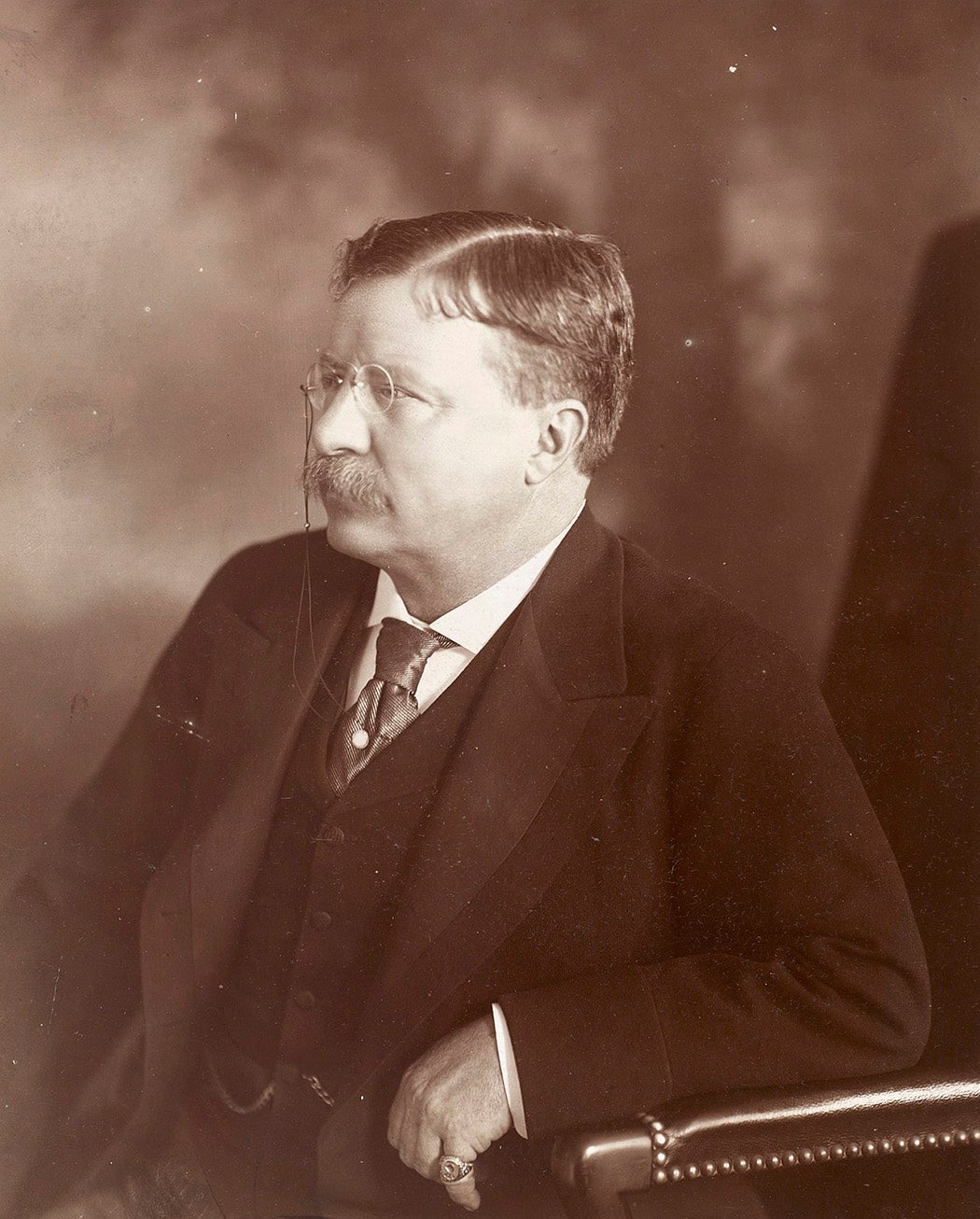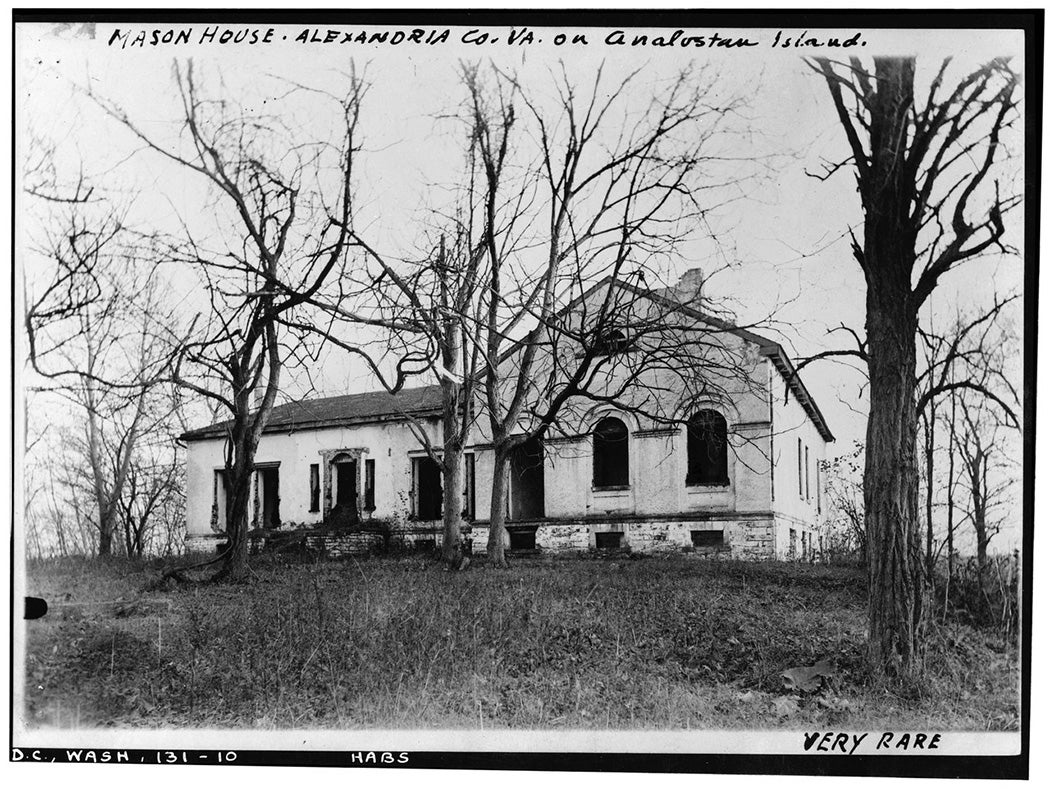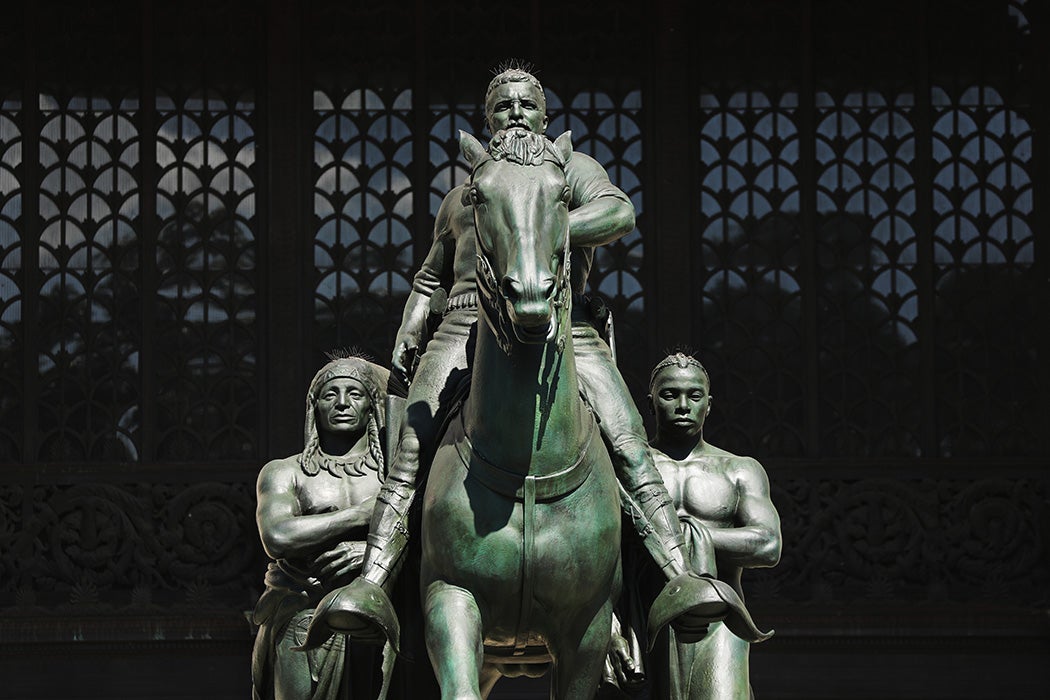Each year, more than 25 million visitors descend on the National Mall, according to the National Park Service. Fanning out, they encounter a circuit of imposing marble monuments dedicated to high-profile former presidents: Abraham Lincoln to the west, Thomas Jefferson to the south, and George Washington—abstractly rendered as a towering obelisk—at the center of this grassy axis. But few visitors to the capital city know about the island in the middle of the Potomac River that lionizes a president of its own.
Theodore Roosevelt Island, which the NPS calls a “living memorial” to the 26th president, is accessible only by a stately footbridge from a nearby Virginia riverbank. Visitors alight onto a dirt clearing adorned with a map shed, a garbage can, and little else. A brief tramp leads to a statue of Roosevelt, flanked by four stone slabs and anchoring a moat-encased memorial plaza. Other than this iconographic scene, the island is blanketed in woodland and swamp marsh. Its trails are more popular with runners and outdoor education groups than with tourists.
Unlike the spatial monumentality of the Mall, Theodore Roosevelt Island appears at first glance to fulfill a humbler purpose: that of a woodsy retreat from the bustling city, dedicated to the president long associated with environmentalism and the expansion of public lands in the American West. As the signer of the 1906 Antiquities Act, which enabled the executive branch to proclaim national monuments without congressional brouhaha, Roosevelt thought it his duty to serve the public by protecting natural resources, Robert Righter explains. During his eight years in office, he set aside Grand Canyon National Monument for conservation lands and expanded the number of National Forest reserves from forty-one to 159.
But Roosevelt was also a hawkish proponent of imperialism and racial domination, and the architect of the interventionist corollary allowing the United States to become a hemispheric occupying force after the War of 1898. In his writings, he extolled the frontier genocide of Indigenous people as the grounds for the ethnogenesis of the white American race. “Roosevelt’s West was a Darwinian arena,” Richard Slotkin explains in an essay on the ideological links between the president and Frederick Jackson Turner. As such, Roosevelt’s anti-Indigenous vitriol and conservationist views were of a piece. The violence of the former enabled the terra nullius theory behind the latter—and therefore undergirds the mainstream environmentalist movement of today, even in its efforts to pursue “work that disrupts the long histories of colonialism and racialization,” as scholars Joe Curnow and Anjali Helferty recently pointed out.

Aptly, the island’s natural appearance is an illusion, obscuring a long and varied history of human settlement before the landscape was reforested as an “urban wilderness” in the 1930s to commemorate Roosevelt. JSTOR’s historical collections flesh out what came before the remote urban park and memorial of today, illustrating the corrosive fantasy of the “wilderness” ideal that animated Roosevelt himself—a fantasy that still lingers in conservation efforts. Indeed, as environmental historian William Cronon polemically wrote in 1996, the notion of wilderness itself “is quite profoundly a human creation.”
The overdue national reckoning with the many monuments to reviled historical actors that populate the American landscape has foregrounded the ways in which a grand stone paean can both invoke and silence historical memory. But in the case of Theodore Roosevelt Island, where a deep landscape history was buried in the name of conservation, the land itself is a provocative monument to its subject. As a palimpsest of the post-frontier “wilderness” construct that informed the origins of public land management in the United States—that is, creating the illusion of an untouched natural landscape—the island memorializes the thorny complexity of an ideology as well as a person.
Weekly Newsletter
Before European colonization, the 88.5-acre island was stewarded by the Nacotchtank tribe, whose traditional territory encompassed much of present-day Washington, D.C. (The names Nacotchtank and later Anacostan and Nacostine were used by early colonists and became part of the place-naming fabric of the capital region. Yet they are not necessarily how the Algonquin-speaking people of this area identified themselves.) From their primary village near the present-day Joint Base Anacostia-Bolling, Anacostan leaders paid tribute to the Piscataway Confederacy and controlled flows of trade at the confluence of the Potomac and Anacostia Rivers. In 1663, colonists seized these riverbank lands through broken treaties. But Nacotchtank people moved to and inhabited what would become known as Analostan Island through the early 1700s, even though Potomac River survey maps indicate that the Maryland legislature conveyed the land to a Captain Randolph Brandt in 1682. While the exact date that settlers displaced the island’s last Indigenous communities is unknown, Nacotchtank descendants ultimately merged with the Piscataway nation in southern Maryland.
In 1717, the Mason family acquired the island; it became a summer hotspot for the early federal city’s burgeoning elite after 1792, when General John Mason inherited the property from his father George and put a sizeable mansion on the island’s highest point. In the late 18th century, the capital region was still a patchwork of estates driven by a plantation economy—enslaved people would soon build the federal cityscape. “No doubt the Mason family’s greatest agricultural success was the cultivation of Analostan Island into a showplace,” according to local historian Mary E. Curry. For this, they could thank David Hepburn, their British head gardener, who went on to co-author a seminal early handbook on American landscaping. Hepburn grew fruit and vegetable trees and planted avenues of poplars and locusts radiating out from the topographic rises of the estate.
This cultivation and the construction of the family mansion was undoubtedly predicated on the labor of the Black people whom John Mason enslaved. According to Curry, Mason’s Georgetown property taxes from 1818 index some measure of human property, though she doesn’t say if numbers or names of individuals are listed. These lives and stories, like those of the Nacotchtank, remain largely unexcavated from the island’s sediment, with one exception.
In her account of Underground Railroad organizers in Washington, historian Hilary Russell tells of William, who was enslaved by Mason and sold to Commodore David Porter in the fall of 1817. William, she writes, “would have waited on descendants of George Mason at his son’s Georgetown residence, and on the many eminent summer visitors to Analostan Island.” He was 24 years old in 1818 when he escaped and sought help from a man named Stephen Potter, who forged his manumission papers. William was re-captured and Potter was charged with abetting his escape, although he was ultimately acquitted; John Mason testified against Potter in the trial.
The violence of the Mason family seeped off the island and into the mid 19th century. Born on the island, James Murray Mason, John Mason’s son, served as a leading advocate for slavery in the Senate. He is infamous for introducing to that body the Fugitive Slave Act of 1850.

In 1833, John Mason lost the island to the Bank of the United States amid financial trouble. A series of owners and tenants then operated it as a commercial garden until the turn of the Civil War in 1861, when the US Army moved in. The United States Colored Troops 1st Regiment, comprised of emancipated Black men and led by white soldiers, was organized on the island in 1863. As the war dragged on, self-emancipated Black families from nearby Confederate territories sought refuge in overcrowded relief camps throughout Washington, D.C.—including on Mason’s Island, where the camp’s purpose-built quarters also housed a hospital, a school for children, a night school for freed adults, and household instruction for women, as recounted in a 1957 Bulletin of the Friends Historical Association of Philadelphia.
Known as “contraband camps” after the designation for formerly enslaved Black people who fled the South and sought protection in the Union, these pop-up villages attracted prominent abolitionist intellectuals who were invested in both their concerning wartime conditions and their generative possibilities for Black community formation. In a November 17, 1864 letter, written from the federally planned Freedman’s Village in Arlington Heights, Virginia and published the next year by the Anti-Slavery Reporter, Sojourner Truth relayed that after government visits and events in the city, “[she] then spent a week on Mason’s Island with the freedmen.” By year’s end, roughly 400 of the 40,000 formerly enslaved refugees in the District region, mostly women and children, were living on Mason’s Island.
Soon after the war ended and the camp was decommissioned, the island’s most recent owner, William Bradley, died. By 1889, the Columbia Athletic Club had picked up the lease and once again transformed the landscape: now it was “well nigh covered with its ball fields, tennis courts, running track, grand stand and all the paraphernalia incident to active exercise in the out-of-doors,” James Franklin Hood wrote in 1919. The last “spring games” were held on June 4, 1892, before the club relocated. The Analostan Boat Club, meantime, made use of the watery surroundings, though the island’s buildings and gardens were “suffering from age and neglect,” Curry writes. A 1906 fire further damaged the weathered Mason mansion.

What would happen to it next was unclear. Articles in the Washington Post and Washington Times indicate that municipal leaders considered a contagious disease hospital and “a public pleasure ground” as options for the island. The Washington Gas Light Company bought it in 1913 to use for gas tank storage, but those plans remained unrealized, while the island became overgrown. Into this uncertainty stepped the Roosevelt Memorial Association (RMA), with the aim of celebrating the two-term president who died in his sleep in 1919 at the age of sixty.
By 1921, Roosevelt’s enthusiastic friends in government had already raised more than $1,700,000 in donations for a memorial. At the time, Analostan Island wasn’t on their radar. Instead, they were gunning for the open spot on the far eastern shore of the Tidal Basin. Pierre L’Enfant’s 1791 grand plan for a gridded metropole connected by diagonal boulevards around the central axes of the Capitol dome and the White House was nearly complete. The 1901 Senate Park Commission had quickly facilitated the construction of the imperial Lincoln Memorial on the Mall’s western end, but the southward counterpoint in the Tidal Basin area remained unfilled.
In 1925, the RMA held a design competition for a Tidal Basin memorial and submitted the winning plan to Congress for approval. It was not forthcoming. Opponents quickly objected to the enshrinement of the twenty-sixth president on the same physical and commemorative plane as the first and sixteenth. “Before the location was irrevocably appropriated, Theodore Roosevelt’s historical credentials received a thorough examination,” Alan Havig wrote in American Quarterly. He continued, “the verdict was that, at the very least, it was too soon to freeze in granite the judgment that he was the equal of Washington and Lincoln.” Congress soon resolved to authorize a memorial to Thomas Jefferson instead. (Of course, Roosevelt got the last laugh as the fourth head on the tourism-oriented Mount Rushmore, carved alongside predecessors at mammoth scale on the sacred Lakota land of the Black Hills.)
The RMA shifted plans, focusing on the overgrown island in the Potomac. In 1931, they purchased it for $363,000, and replaced their conventional annual report with a pamphlet outlining the site’s resonances with Roosevelt not as a democratic unifier but as a hiker and conservationist.
“The Island gives an impression of wild country peculiarly appropriate as a setting for a memorial to Colonel Roosevelt,” they wrote.
The RMA hired Frederick Law Olmsted Jr. to oversee a restoration of the island’s plants, trees, and wildlife. The Civilian Conservation Corps arrived in 1935 to “re-wild” the overgrown remnants of the island’s multilayered material history under Olmsted’s direction; they planted roughly 20–30,000 hardwood trees and shrubs. The goal was a “climax forest,” which meant the cultivated landscape had to be cleared, including the remaining walls of John Mason’s house.
Representatives from the Historic American Buildings Survey (HABS), a New Deal-era program dedicated to protecting the country’s architectural legacy amidst rapid development, stopped by in 1936 to quickly excavate and document the Mason house before vestiges were torn down. As Mark Schara points out in Washington History, the study’s sixteen drawings, 72 photographs, and 24 pages of data made it “easily the largest HABS project undertaken in DC to date.” Yet this documentation focused on the house only; deeper archaeology was left to the teeming underbrush.
After the national park site opened in 1938, Olmsted Jr. and the RMA clashed over whether to include a statue honoring Roosevelt. Monumental tradition won out, and the memorial plaza and figure, designed by architect Eric Gugler and sculptor Paul Manship, were unveiled in 1967.
Today, historic maps are the only way to identify where the Mason house once stood. Harder still to locate are the Civil War-era Army barracks or the Black contraband camp. There is but a single archeological study of Nacotchtank lifeways on the island; it was conducted more than fifty years ago.
For all that, the Island is hardly the most well-known of memorials to Theodore Roosevelt. That honor may go to the Equestrian Statue of Theodore Roosevelt, which presided for 82 years in front of the American Museum of Natural History in New York and was removed by the city in January 2022 after five years of focused public outcry. The pyramidal statue depicted the former President on horseback atop a white supremacist hierarchy of human difference: a Native American man on Roosevelt’s right-hand side, and an African man on his left.
This sculpture has been relocated to North Dakota, where it awaits the controversial Theodore Roosevelt Presidential Library slated to open on July 4, 2026.
Support JSTOR Daily! Join our membership program on Patreon today.







